Measuring how students approach goal-setting in the 5th and 6th grades
Educators at Wallingford Elementary School and Shrewsbury Mountain School, in central Vermont, undertook an action research project measuring how their use of digital tools — specifically Google Docs, Forms and Sites — changed how middle grades students approached setting goals and reflecting on their achievements.
Both schools are 1:1 with MacBooks.

Transcript appears below.
Educators:
- Pat Bowen, 5th grade, Wallingford Elementary School
- Carie Dinnan, library/media specialist, Wallingford Elementary School
- Helen Richards-Peelle, principal, Wallingford Elementary School
- Sheila McDonough, 5th and 6th grades, Wallingford Elementary School
- Barb Naughton, 6th grade, Wallingford Elementary School
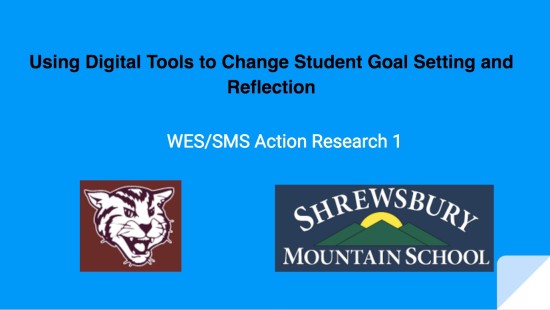
Pat Bowan: Our focus this year, was that we attended the Middle Grades Institute this summer, and we worked on using digital tools to change student goal-setting and reflection. We’ve done some goal-setting with students in the past, but not in as systematic as a way, nor as personal of a way. It was really teacher-driven and parent-driven and we tried to shift towards more student-driven and more reflection on those goals.
We worked together as the 5th and 6th grade teachers at two schools. Shrewsbury is about 15 miles from Wallingford, so we had meetings every Friday via Skype. We would process what we had done the previous week and talk about what we’d be doing next week towards our work with students.
That was a new way of collaborating, for us.
We’d done other things together — the Dorothy Canfield Fisher list and Battle of the Books and other things, but this was another way of connecting two schools in our district.
We wanted to implement the goal-setting and reflection process with students in a better and more personalized way. And students at our school are in a 1:1 environment at our school: each student has a MacBook, but they do not take it home. And it’s the same at Shrewsbury.
We wanted to increase their engagement and their investment in learning, especially in the 6th grade, which is when kids start to really make judgments about whether what we’re doing is valuable or not.
New levels of collegiality
We used our PLC (Personal Learning Community) time to meet. Not only did we Skype on Fridays, but also sometimes during our PLCs, which is a double special block of 80 minutes when the 5th and 6th grade teachers meet and talk about curriculum — from time to time we brought in Sabrina from Shrewsbury via Skype, as well as Rachel Mark, professional development coordinator for the Tarrant Institute.
Our abstract:
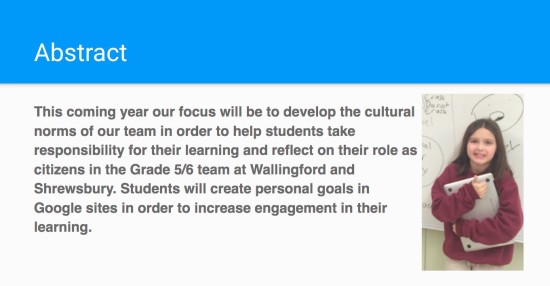
It was Wallingford students’ first experience in using Google Sites and setting up their own sites.
Sabrina McDonough: For many of Shrewsbury’s students, they may have been familiar with Google Docs, but not all of them had used Google Sites.
And when we talked about their role as citizens, we included Common Sense Media, the digital citizenship curriculum. We did a lot of work with that prior to the work we did with reflection.
Data collection methods
We wanted to collect data so we could look back at the beginning of the year and take note of what progress had been made. So we started with a beginning of the year survey. We just had some simple questions that we wanted to ask students about goal-setting:
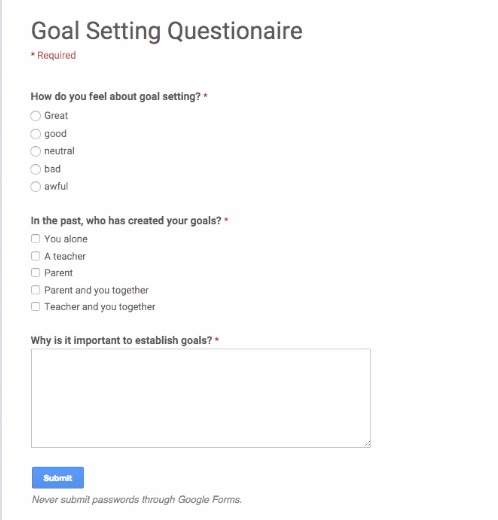
And not just that but we had an initial prompt for them to use:
“In 20 words or less, why do you think goal-setting is important?”
And then so we could compare, just recently (after the mid-year break), we gave them another survey, but added a few more questions:
We revisited why they thought it was important to establish goals, but since reflection is the part that we really wanted to focus on, we added “How often have you reflected?”
When we talk about implications, that’s the piece that we really want to work on: how we can embed reflection more throughout our time. What was interesting was that some of the answers changed for who initially helped you create your goals. Some of them originally answered that parents or teachers helped them create their goals, and then the second time they stated that they and their parents created their goals. Not quite sure what that shift represents, but it’s very interesting.
Their ideas about how reflection had helped them with setting their goals and what evidence they were going to collect to show those goals were evident.
The final one we have not yet given is a parent survey, just so they can see, for some of them, this was the first time they’d really talked to their parents.
Student-involved conferences
At our conferences in October, we did student-involved conferences. We weren’t ready to make the leap to student-led conferences yet, but Shrewsbury students in particular started off the conference by sharing their Google Sites that we had used to post their goals. They afterwards made their own reflections (and posted them to the Sites) about being involved in the conference. And for many of them, this was the first time they’d been to one of their own conferences.
Implementation plan
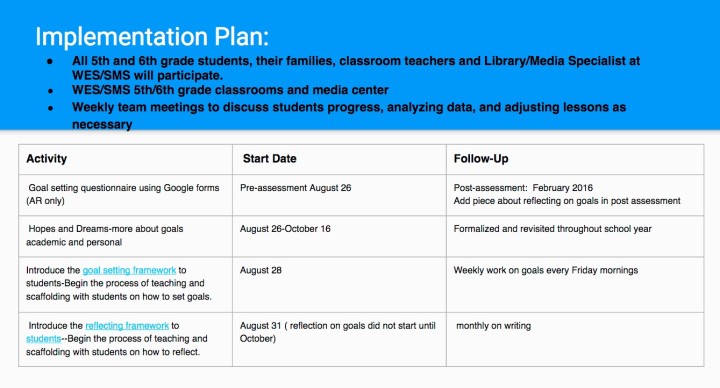
We started with the goal-setting questionnaire. We also wanted to do hopes and dreams. We primarily focused on academic goals, but also gave them the opportunity to focus on the personal goal as well, gave a lot of students buy-in into the goal-setting process.
We did start with hopes and dreams and some identity pieces — some identity boxes and bio poems — and a lot of those they posted on their sites as well.
Then we hoped to work on our goals. Now, we had aimed to start the goal work on August 28th, but we quickly realized that was a very lofty goal for ourselves, and it took us a little bit longer to come up with a format we wanted to use, and we’re still working on that.
We did use:
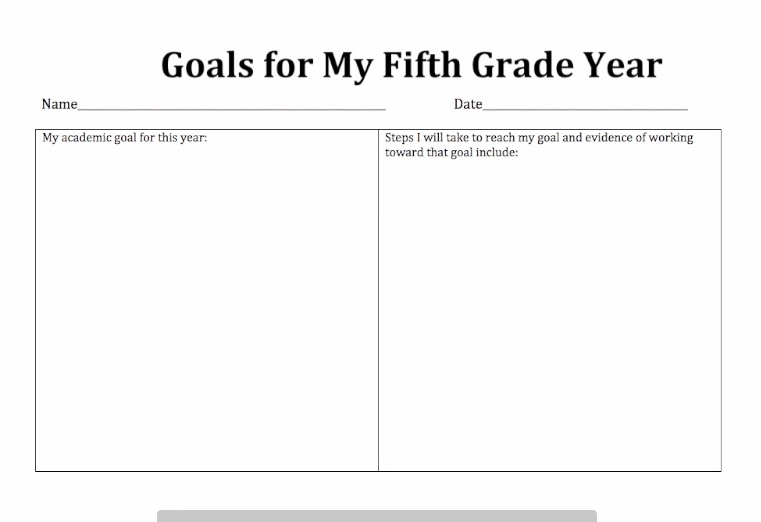
We had them, within Google Docs, fill out the questionnaire, answer a few questions about both their personal and academic goals, and then be able to add those to their Google Sites.
With the Shrewsbury students, I also used this format:
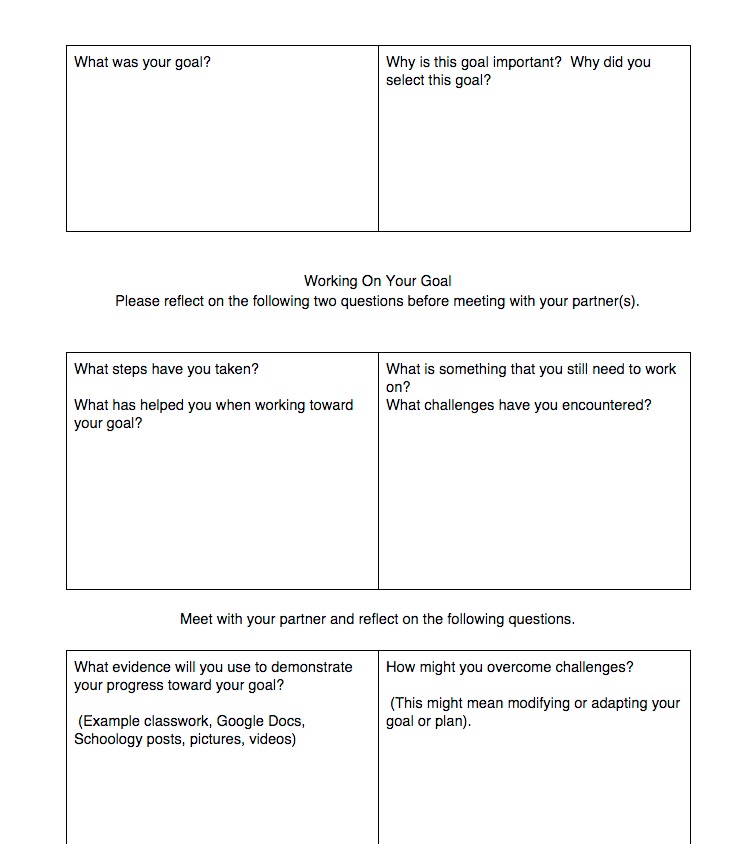
They worked by themselves first, to start thinking about what their goal was, just to refresh their minds about why it was important to them. And then they had a couple of questions I wanted them to think about before they met with a conferencing partner. They thought about the steps they had taken, as well as something that’s a challenge for them still, something they have to overcome, something they’ll need to work on in the future.
And then after thinking about those pieces, they met with a partner.
I actually conferenced with a student: I filled out one of the organizers for myself, and then one of my students, we conferenced back and forth and filled them out together.
Then after they met with their partner, they thought about ways to gather evidence. What are some forms of evidence I could use? What are some ways I can overcome those challenges? And that was great to have modeled that with the students, because they could talk back and forth and see it was a conversation: they didn’t have to do this by themselves. It was a partnership.
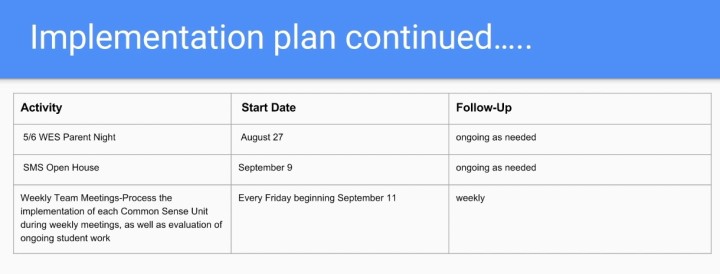
Before we started a lot of this work, we did meet with parents. Wallingford had a special meeting to talk about the project, and the Tarrant Institute’s involvement. My conversations with parents were embedded in our existing open house (as Shrewsbury is such a small school).
And then we wanted to make sure that we had time to come together as a team and talk about some of the obstacles students were seeing, what were some of the successes we were seeing, and how we could keep moving our work forward.
Data results
Carie Dinnan: We have all the results from both questionnaires, but here are the highlights. The charts shown below address the question “How do you feel about goal-setting?” as measured in the beginning of fall and again just recently after we returned from the mid-year break.
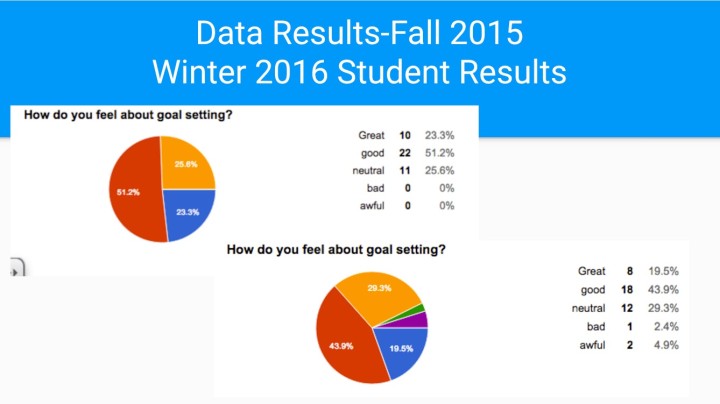
It’s interesting; I’ve spent a lot of time looking at these results, and I feel like we need to shift more students from Neutral to Good. We need to improve on the process so we get kids more engaged.
These too, below, are from the fall, and addresses the question “In the past, who has created your goals?”
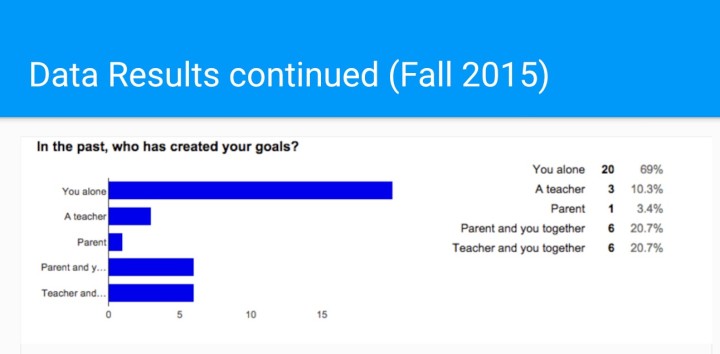
This is a question of interest to us, as we move forward in this PLP process with kids, it’s important to know that kids are understanding the process is really about themselves, and what their learning is about. It’s not about what we think, as teachers and parents, they should be learning.
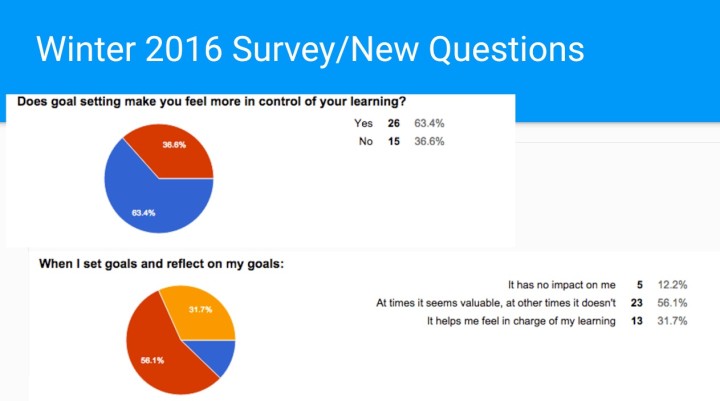
And then this was part of our winter survey:
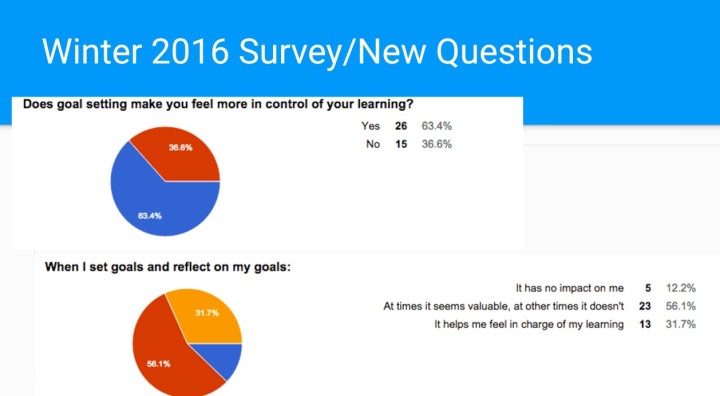
We also wanted to share a summary of some of the responses in regards to “Why is it important to establish goals?”
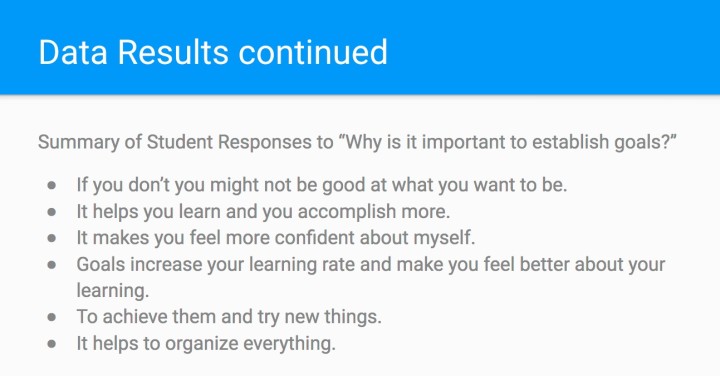
Implications for teaching
Helen Richards-Peelle: Moving forward, this is the opportunity for teachers to reflect on this great work they’ve been doing all fall. What do we need to be doing? What do we need to do to shift our own practice forward, to benefit student learning and these goals they’ve set for themselves.
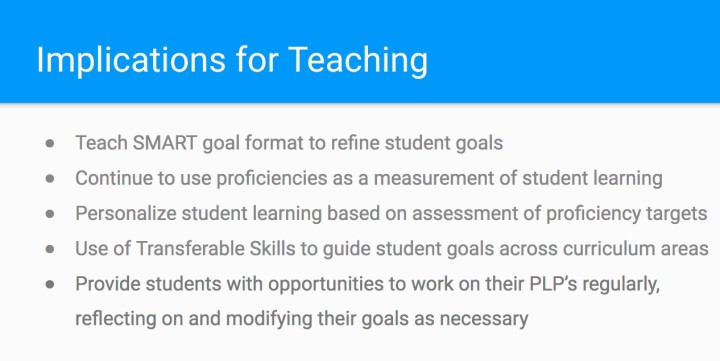
They’ve done some really great thinking around SMART goals and proficiencies, and this will be the journey we continue on for the rest of the school year.
Anybody else who’s been wrestling with the same questions and the same kinds of ideas, we’d welcome any feedback to help us on this journey.
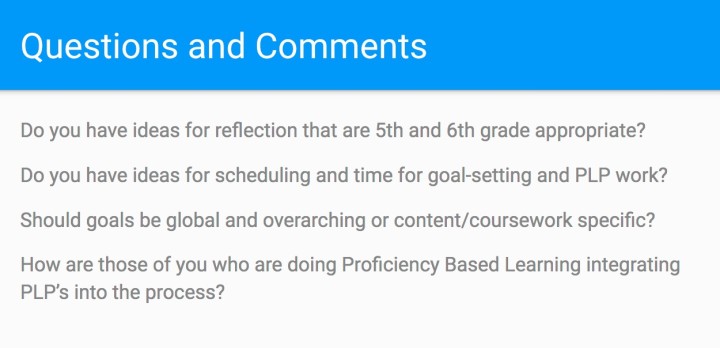
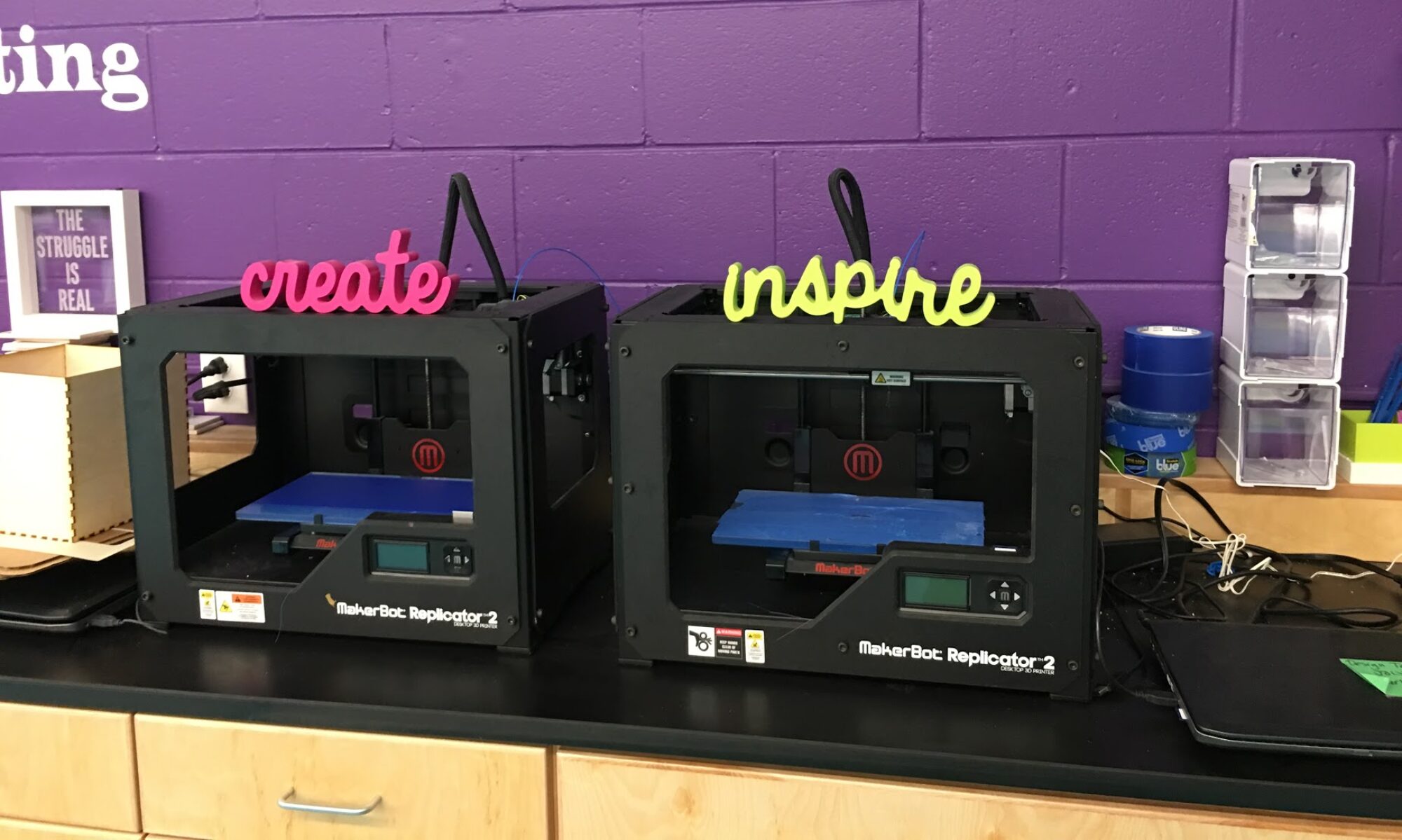

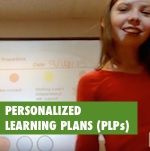
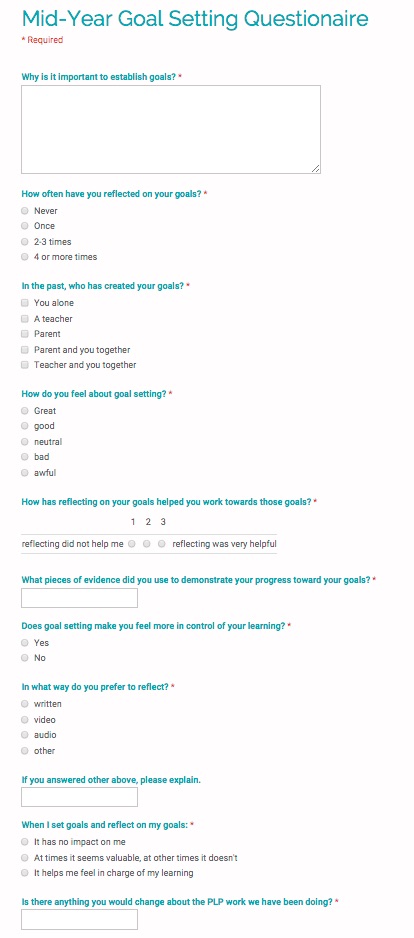
Using digital tools to change student goal-setting and reflection #vted https://t.co/HEr9QsHRS2 https://t.co/FOaI1dMrPv
RT @innovativeEd: Using digital tools to change student goal-setting and reflection #vted https://t.co/HEr9QsHRS2 https://t.co/FOaI1dMrPv
Using digital tools to change student goal-setting and reflection https://t.co/WhnwCHczm0
Tools for teachers: Using digital tools to change student goal-setting and reflection https://t.co/tOhdijdfU4
Educators from two schools in central Vermont share how they’re using digital tools to change s.. https://t.co/2eRV5C3Afm #Disrupt
RT @innovativeEd: Using digital tools to change student goal-setting and reflection #vted https://t.co/HEr9QsHRS2 https://t.co/FOaI1dMrPv